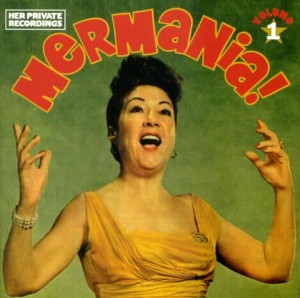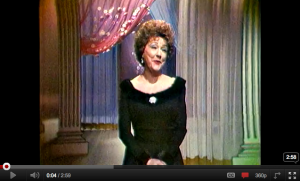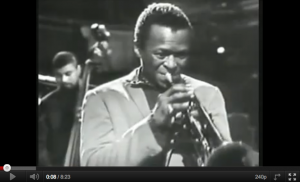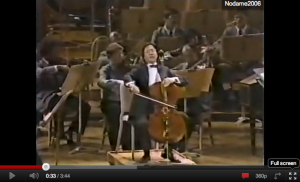Almost all of us are guilty of it: repetitive, auto-pilot vibrato.
Can you blame us? Between choosing the right notes, and trying to play them in tune and in time, we don’t always have surplus brain cells to shape each note individually. So much simpler to stamp each one with the same prefab wiggle!
One of the wickedest observations about shred guitar came from one of the greatest shred guitarists, Paul Gilbert. In a conversation many years ago when he was a youngster, he noted that a lot of players seem to have pilfered their vibrato technique from Ethel Merman.
For 50 years Merman deafened electrified Broadway with her remarkably loud voice and, um, distinctive brassy style.
Okay, just imagine a hyper-distorted guitar instead of a woman’s voice, and shred licks instead of a Cole Porter melody. (You don’t really need to visualize different hair.) Doesn’t that relentless eighth-note-triplet vibrato evoke memories of those idyllic weekend afternoons at Guitar Center?
As a point of comparison, consider the relatively spare vibrato of Miles Davis and John Coltrane:
According to jazz legend, Miles’s trumpet teacher, Elwood Buchanan, would rap the young trumpeter’s hand with a ruler whenever he played with gratuitous vibrato. “You’ll shake enough when you get old!” he’d scold. (He was wrong, though—even late in life, Miles applied vibrato only minimally.)
I’m not arguing that vibrato is bad, or even that it’s better to sound like Miles Davis than Ethel Merman. The issue is whether we’re truly shaping each note to suit the musical context, or thoughtlessly forming them with the same cookie-cutter.
Here’s another humbling clip:
Dig the intensity Yo-Yo Ma brings to the simple, slow melody. Every single note is positively sculpted from scratch. I pains me to realize how rarely I inhabit my notes this way.
Obviously, this is personal stuff, and I’m not about to dispense a one-size-fits-all solution. But I do have a few ideas to think about and try:
- Experiment with different vibrato speeds. Play whole-notes to a slow click (that is, long notes sustaining across four clicks), alternating between two pulsations per click, then three, then four, then six, then eight, then back down again.
- Experiment with different vibrato styles. Try alternating between B.B. King-style, pivot-from-the-wrist vibrato, “vertical” vibrato in which your fretting hand moves perpendicular to the strings, and “horizontal” vibrato, moving parallel to the strings as bowed-instrument players do. Try all three techniques with your thumb anchored to the back of the neck, and also with your thumb floating free from the neck. (The latter approach usually yields a stronger, potentially wilder vibrato.) Note that in most cases, pivot and vertical vibrato alternate between standard pitch and slightly raised pitch, whereas horizontal vibrato can both raise and lower the pitch relative to standard.
- Experiment with deliberately omitting vibrato. Try playing quarter-notes against a slow click (that is, one note per click). Try applying vibrato only to every other note. Or every third note. Or every fourth. Remember, while vibrato adds interest and variety to your notes, sustained notes do interesting things over time even when no vibrato is applied.
I promise you that a mere five minutes invested in any of the above exercises will have a massive effect on your subsequent playing session. You’ll be vastly more mindful of your vibrato and its effects. And whichever choices you make, they’re likelier be choices, not reflexes.
BTW, who are your picks for players with great, deliberate vibrato? Jeff Beck is always going to be near the top of my list . . .












I remember an interview with David Gilmour where he explained how he tried to achieve a singer-like vibrato by sustaining a note and then slowly adding vibrato at the end of the note.
I also like Richard Thompson’s technique, which is very spare.
Two great examples concerning two great players! Not only is Gilmour’s vibrato beautiful, but it’s perfectly suited to the slow tempos and spacious arrangements that usually accompany them. And notice the similarities between Thompson’s guitar and vocal vibrato. Whether singing or playing, he often sustains a long note with a hard, almost grating timbre, creating great tension against the shifting accompaniment. On the other hand, he sometimes shifts to a wide, wild, almost spasmodic finger vibrato. I love how he goes to those extremes, instead of slathering the same lukewarm vibrato on everything.
Very interesting post.
A reason why I don’t listen to opera more often (and some guitar hero’s too) is because of the excess of vibrato. Some historically informed recordings correct this problem and are way more pleasant for my ears.
Once I found a paper where a musicologist compared early orchestral recordings with more modern ones and found tha around the 20’s and 30’s of the XX century, orchestras (especially the string sections) started to execute vibrato almost continuously. A fashion that still lasts… But the point is that continuous vibrato was not in the mind of the composers until the XX century. Wich I find very interesting.
Well, the history of classical vocal style is fascinating! One interesting thing is, composers have ALWAYS bitched about the stylistic excesses of singers, and how they just can’t resist adding absurd vibrato and gratuitous ornamentation—basically, just showing off. Really, some of the complaints composers made about performers hundreds of years ago could have been written about last week’s episode of American Idol.
Instrumental vibrato certainly got more excessive over the course of the 19th century, and early 20th-century recordings definitely display that tendency. I grew up hating that stuff, but now, I find it kind of fascinating, and sometimes beautiful in an antique sort of way, and I can enjoy how it evokes another time and another attitude.
As a player, I suspect I’ll always veer toward the under-vibratoing side of the spectrum. But my issue here isn’t really about more vibrato or less vibrato, so much as players who shape notes on auto-pilot. A group that, sadly, often includes me. 🙁
I always liked Robin Trower’s vibrato. Sometimes overdone, but I’m impressed with the intensity and speed with which he does it.
I heard Trower live when I was 12. First really good player I ever heard live!
I remember being in church with my grandma as a kid. She had powerful pipes and over the top vibrato and would drown out everyone in the congregation-it drove me crazy (and not in a good way). When I started gigging in the late eighties, I heard the same excessive wobble from all the poodle hairs-it too drove me crazy. I would go on to develop several different approaches from classical style, to a Fogerty-esque twitch, to a more BB/Otis Rush/Albert Collins type thing. These days I tend to play a fair bit with really fifties-minded characters in country and blues situations; under those parameters, the challenge is to avoid using vibrato almost altogether! Electric guitar vibrato is a product of the “slinky string” revolution; music that was created when everyone was still stringing with Black Diamonds sounds weird with finger vibrato. Thanks to that we had a generation of awesome slide and steel players, not to mention the unhinged whammy abuse of Ike Turner.
You want a challenge? Try playing with NO vibrato and making it really sing! (Hint- partial bends).
Very good post about a very overlooked aspect of the vibrato! Thank you for sharing your ideas!
As for an example of very good vibrato style – my favorite is Paul Kossoff (Free).
Yeah, Kossoff is so underrated — though at least Joe Bonamassa makes a point of singing his praises every chance he gets.
Hey — you’re not related to Henri Lazarof, are you? My old compostion prof in college back
in the Gold Rush days of ’49when I was young.Well, I am from Bulgaria too. And it is a shame that this is the first time I hear about Henri Lazarof…
Btw, Lazarov/Lazarof/Lazaroff (Лазаров in Bulgarian) is a common surname here.